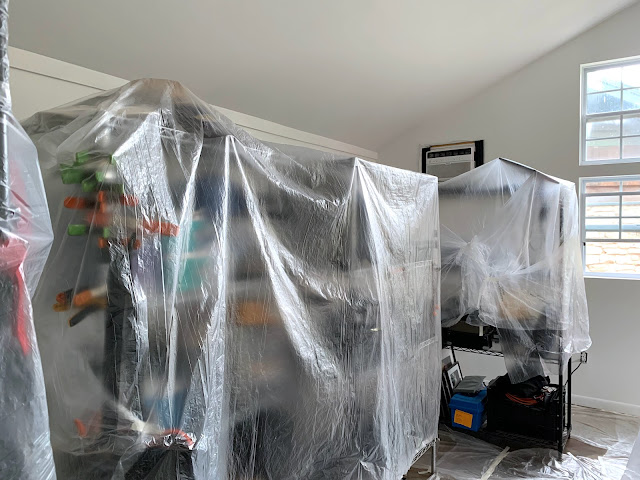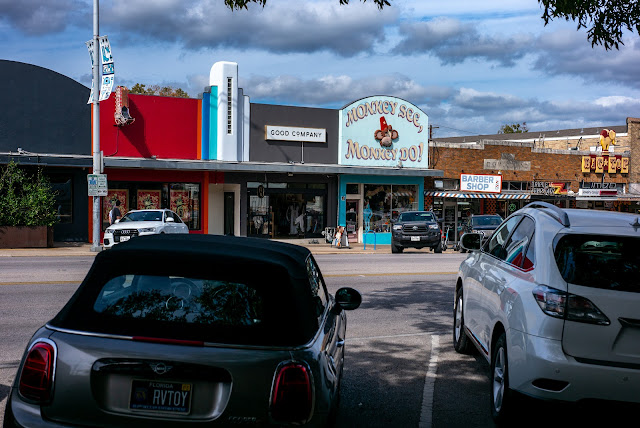Saturday, November 11, 2023
Back in the office. Polished the computer and the hard drives. Sorted cameras. Sat back and admired clean, white walls. Went swimming.
Wednesday, November 08, 2023
Painting complete. Client (me) happy as a clam. House and office nicely refreshed.
Global Shutter arrives. World radically changed within hours. Early adopters already ensconced in the Photography Hall of Fame. All previous cameras rendered useless.
Here we go. The GSO. The global shutter onslaught. Breathless bloggers and video influencers have also changed history by declaring that Sony has invented a whole new way of capturing images that no one else in the world had the foresight or technology to create.
Well.... maybe not so fast. I think a small company that designs and produces imaging sensors solved the technical stuff of G.S. well over a decade ago. For that matter Arriflex, Red, and Panasonic have been using global shutters in high end video cameras for.....a long time. Quite successfully. Sony basically fine-tuned the sensor and imaging pipeline technology in order to help you fill up memory cards much more quickly, in a consumer camera, and with many nearly identical frames. Just like video.
Don't get me wrong. I think global shutters are, in theory, a great idea. They solve some problems. But whether they are the problems we needed to solve is yet to be determined. Is a super high frame rate a good thing? Maybe, but maybe it creates a worse problem by allowing one to generate so many nearly identical files that memory cards quickly fill up, hard drives get overwhelmed and editing time extends egregiously which cuts down on time for human enjoyment.
Here's a prediction: As soon as global shutters trickle down to affordable, consumer digital cameras, and the "feature" of an "endless frame rate" arrives with them software companies will almost immediately come out with "AI" software that learns your taste in photographs and automatically winnows down your take in a folder. Effectively homogenizing your vision based on what you already did in the past. Work that falls outside your software's learned "taste" parameters gets dumped. Even if it's something you thought to try in a new way. The software will require faster processors and bigger, faster SSDs to operate. In one camera purchase you've created a new need to upgrade vital parts of your computer and your image processing.
A fact check: Loss of quantum efficiency. Global Shutter sensors can't currently take advantage of BSI technology and depend on older semiconductor tech. Current sensors used for global shutter photography are between one and two stops less efficient which equals one or two stops more noise.
And then there is the engineering workaround to delivering speed; and speed is what lies at the base of a global shutter implementation. Each file that comes off a sensor; each frame, must be processed by the camera. Hundred thousand dollar movie cameras get around the need to process their files in camera by dumping all the raw information off the sensor and directly into large scale, high speed memory. Super fast SSDs. The raw results (flat, dark, low saturation, etc.) are only made "visible" and workable in post production. Or, in movie cameras, review outputs that have their own adjustable Log profiles.
Current users of high end still cameras have been spoiled. With current frame rates from mechanical shutters cameras have time to take raw data and profile with white balance settings, contrast, saturation and other settings in order to make a pleasing and (hopefully) representative smaller file to delivery to your camera's rear screen or EVF for your immediate viewing or preview and review. The files have been profiled, your camera settings incorporated, etc. It happens to every frame that comes through your camera. Otherwise you couldn't really make much of an evaluation when reviewing the images on your camera screen.
But here's what is almost never mentioned about cameras and speed, it's the compromises between the throughput of the camera and the amount of time and processing power being lavished on each frame. In order to give you the faster frame rates that many desire something has to be streamlined. To keep costs down parts in the camera (sub processors, main processors, GPUs, etc.) have to be evaluated and compromises have to be made to meet budgets. You could have better color and lower noise out of current sensors if you were willing to pay in terms of battery use, overall cost and increased camera body size (to handle thermal issues...) but too many consumers only see the top level specs. Those are resolution, frame rate and PRICE.
Price being the ultimate "deal killer". But also the compromises required to hit a price point have a direct effect on image quality. As far as speed goes, all else being equal, the faster you pull frames through a camera's pipeline the less time the camera's working guts have to apply processing to each image. If cost and frame rate are fixed conditions for a camera (to hit the all important price point) then the maker cuts cost in the invisible to consumers areas. They can take a slower imaging processor (the unit that applies corrections and writes output data after files come off the sensor) and reduce the number and/or complexity of the operations the imaging processor undertakes. Do you wonder why very high end Phase One cameras work in the realm of 16 bits while many popular Sony full frame cameras work in the pedestrian realm of 12 bits? It's because churning out highly detailed and data dense 16 bit files requires more (and more expensive) parts and processing. It's also a reason why cameras with very high degrees of color discrimination process files at a slower speed than the one's which paint files with a broad and not very discriminating "brush."
Color discrimination is the process of breaking file's colors into finer and finer differentiations of tone and hue. The finer the color discrimination the more accurate and nuanced the color coming out of the camera. Less color discrimination and you get a less accurate representations the colors in your images. Would you personally rather have more speed or more color discrimination, the ability to work with files that have higher bit depths, and files in which noise is treated with a scalpel instead of a sledge hammer?
Granted, faster and faster processors will narrow the gap. But only if the makers of cameras earmark the speed increases for file quality over speed and throughput.
So, yes, the new camera with the global shutter from Sony is an engineering marvel but like any camera it's host to a number of compromises. Higher noise, vis-a-vis current top line 24 megapixel BSI sensors. Lower dynamic range. And almost certainly a processing pipeline that includes 12 bit processing as the default for all raw files. But you do have the nice features of being about to shoot with flash at any shutter speed and the ability to use super high shutter speeds. But with much more limited dynamic range.
Oh, and I almost forgot, the ability to fill a 256 Gigabyte memory card in the blink of an eye.
Processing. As in most computer based endeavors how processing power is used is a continual trade off between consumer candy features (speed) and real, state of the art image quality. Just sayin'
If you are heading to the Olympics next year to shoot still images for Sport Illustrated or Obscure Sports Quarterly and you are horribly unsure of your skill, timing, etc. A new camera with a global sensor might be just what the editor ordered. Hold the shutter button down long enough and you'll have something for A.I. image selectors to choose from. Every new technology that trickles down into photography has some positive use case, but that's separate from everyday value to most photographers.
I'm sure the new Sony A9III is a miracle of sorts. But every photographic miracle comes with some sort of balancing compromise. Old saying.....there's no free lunch.
Tuesday, November 07, 2023
OT: Crazy Times at the Pool. What was I thinking???
I'm happy to be swimming with a competitive team now that I'm 68 years of age. Every workout seems sweeter. Every little victory delicious. Just finishing a hard set seems more fun. More rewarding. And, interestingly, I'm not slowing down. Much.
Today we were coached by Jenn. She's our toughest coach.
The warm up was standard fare. 400 yard swim, 400 pull, some kicking sets, A thousand yards with which to loosen up the muscles, find one's rhythm and get the heart rate up. But today's main set was intense.
We did two sets of 20 x 50 yards. That's not so unusual but the intervals were. We were asked to choose a "challenging" interval for the first set of 20 ( times two lengths...) and then choose an interval that was five seconds faster per 50 for the second set. My lane mates chose 45 seconds per 50 for the first set and then 40 seconds per 50 for the second set. Mercifully, there was a break between the two sets. But a "break" at swim practice still means doing yardage. For us it meant a 300 yard dolphin kick. But that was restful compared to the main sets....
Some lanes chose to do their sets on more relaxed intervals but no lane selected faster intervals. We got into a pace we could sustain and which, for the first set, gave us about 5 or 6 seconds rest between 50s. The second set was almost touch and go. A few deep breaths between 50s. A second or two of rest.
In the end we knocked out about 3300 yards in our hour workout. But man, those were some fast yards with micro amounts of recovery. I'd feel more smug about finishing a set like that except that our lane leader today is just a bit older than I am... There is a lot to be gained by not succumbing to our culture's perspective on age and performance. We can do a lot more than most people imagine.
Now, back to the house painting adventures... (going well).
Monday, November 06, 2023
After a weekend of pulling out stacks of paper, moving filing cabinets, rolling up carpets and other prep work for house upgrades there was a lot of pent up desire to be outside with a fun camera.
One Danger in Dealing with Retirement. Or even the Expectation of retirement.
I'm a sucker for clouds. Puffy ones stuck in contrasty blue skies, especially.
A reminder that everything here at the blog might slow down from now until Wednesday. The painters are here. The computers are moved. Everything is chaos. Pretty much normal...







































